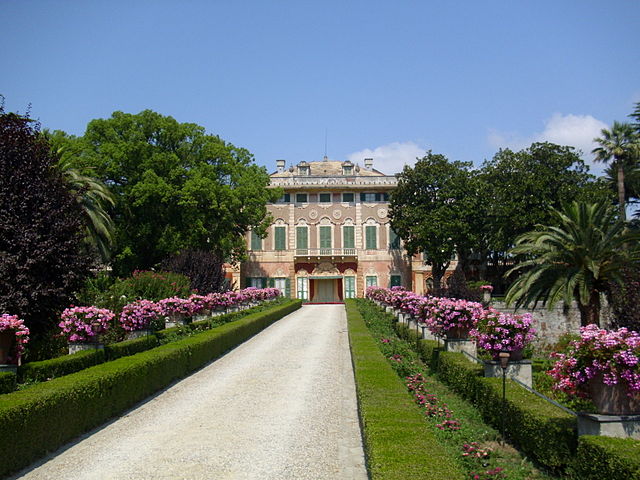Villa Durazzo Faraggiana: a Noble 18th Century Villa
27 Aug, 2014
Events Ligurian Cuisine Notizie

In Albissola you would be surprised by the 18th century Villa Durazzo Faraggiana with its Italian garden, its original exedra and its extraordinary charm; not to mention the Villa itself, which is one of the rare examples of Ligurian Barocchetto.
Inside you can find frescoes, tapestries, paintings and statues, some of them dating back to 1600.
The History of Villa Faraggiana
The building of the Villa, which was commissioned by Eugene Durres, begins in 1717 and ends in 1735.
“Elm Tree Palace” is its original name and the Marquises, who live year-round in Genoa, use to spend their holidays here boasting its beauty on every occasion. Wouldn’t it be gorgeous to be a guest in such a dream Villa?
The property belongs to the Marquises Durazzo until 1821, when Marquis Marcello gives it to the Marquises of Novara Jerome and Joseph Faraggiana.
The estate is owned by the family until the last descendant, Alexander, who bequeaths it to the city of Novara at his death in 1961.
So, when you walk about in the garden of the Villa, it is like stepping on the soil of Novara: isn’t it weird?
Italian-style gardens
The construction of the gardens begins in 1738.
The park of Villa Faraggiana shows an Italian-style architecture with symmetrical designs, sculptures and fountains that blend with the French- style presented in the lower part of the premise and view point of the whole park.
We must not forget that all this is part of a wooded area context that surrounds the villa with its typical “terraces” of olive groves and maquis.
As a result, the Marquises Faraggiana transform the garden into a sort of family farm producing cereals, wine, olive oil and the typical Ligurian chinotto, a fantastic citrus for which our area is well-known still nowadays. The products are sold directly by the producers. You can infer that the Marquises had seen well in advance what would now be on –farm tourism!!
The Marquises had a surprising entrepreneurial spirit: in fact, they do not only settle for an agricultural production but also plant mulberry trees outside the Villa in order to develop the silkworm rearing. This practice was not present in Liguria then.
The Marquises are really ahead of their time!
The Faraggiana family arrange the gardens detaching from their original design. To the Marquises we owe the irregular shaped beds around the pond just in front of the main entrance to the Villa and the tall trees like cedars, magnolias, hibiscus, camphor and the citrus fruit-trees that cannot miss in a Ligurian garden of such an entity! In this area in front of the entrance there is a rare and large specimen of Sofora Iapponica near two fishponds adorned with tritons, masks and statues of Bacchus and Diana.
In 1963 the Municipality of Novara decides to remove the citrus trees orchard in front of the Villa to expand and renovate the gardens according to an Italian-style architecture.
My memory goes to when I was a child:
I’m having my usual walk with my grandmother in the gardens of the Villa: it’s spring and we collect pansies. It’s plenty of them and the air reeks with an inebriating scent of sweet springtime flowers. I can imagine the ladies in their gorgeous gowns walking with their ever- present parasol, wearing elegant hats, accompanied by friendly and polite gentlemen who give them way at the entrance of the Villa. I imagine the cars that cross the avenue in front of the exedra, I can hear the sound of wheels crunching on the gravel along with the clatter of horses’ hooves.
The Four Seasons Gallery
The spectacular gallery dates back to Marcellino Durazzo, Doge of Genoa, who entertains there his very important Genoese guests in summer feasts and celebrations. The Seasons Gallery is very elegant with its paintings, stuccoes, statues and the arcade leaning onto the garden. The amazing and sophisticated gallery is painted with scenes from the life of Diana on the vaults, while the floor is made of tiles that represent the ancient and famous Ligurian tradition. They are all hand-painted in polychrome and geometric style.
The Gallery also shows wooden statues carved by the Genoese sculptor Filippo Parodi in 1667 and taken to Villa Durazzo. They represent Narcissus and the Four Seasons.
Deities of the woods and forests as Flora, Ceres, Bacchus and Saturn do not obviously miss in the Galleria.
Chapel of Mercy
This is the private chapel of the family; originally it was painted in pastel colors but it was then repainted in brighter colors and particularly brighter shades of azure blue and blue in honor of the Virgin of Mercy (blue and white are the colours of the local traditional ceramics)
The Chapel has a painting above the altar due to Giovanni Agostino Ratti representing the apparition of Our Lady in Savona.
On either side of the altar there are spaces reserved for the Marquises, while the central area is reserved for the inhabitants of the surrounding houses who can share the Holy Mass with the Marquises.
Golden Room
This room was commissioned in 1845 by Joseph Faraggiana, who furnishes it with sumptuous gilded furniture and a more sober study and a prayer bench. The floor, also in this area, is made with majolica tiles from Albissola.
Schedules and evening opening
The Villa is open from March 21st to October 5th from 15.00 to 19.00 (last tour h. 18,15) except on Mondays which is closing day. This year there is also an evening opening, every Wednesday at 21.15 with a guide tour inside at 21.45..
Wouldn’t it be nice to visit Villa and gardens at night?
Come and discover the charm of Villa Faraggiana during a stay in Albissola and find out all the promotions that the hotel offers you this season!
